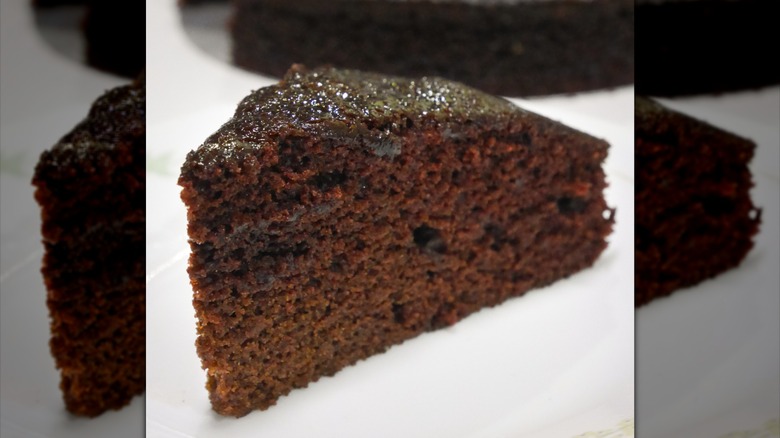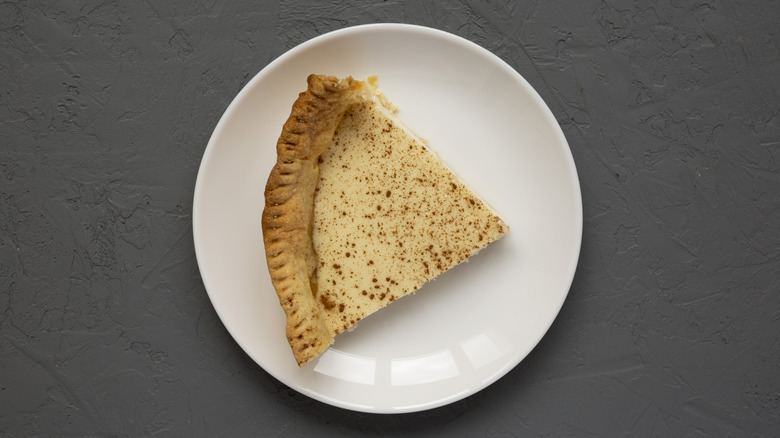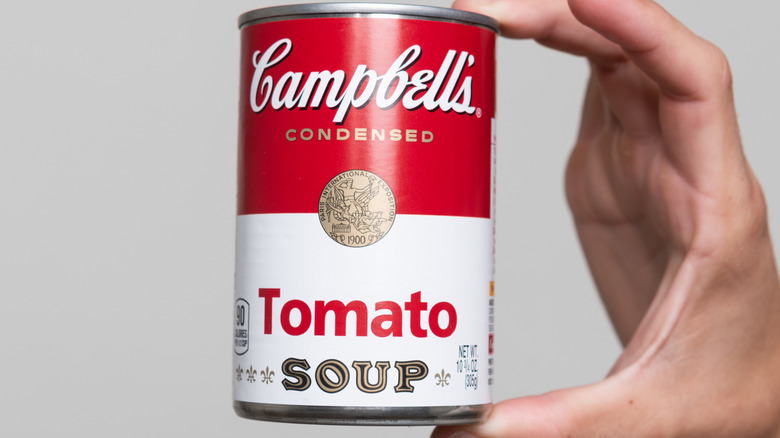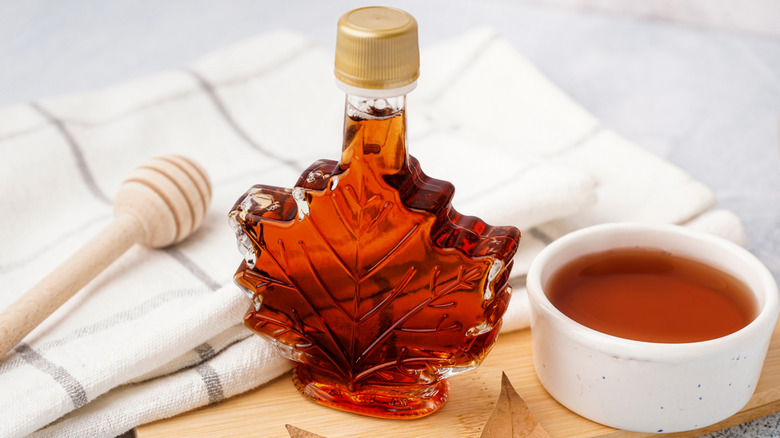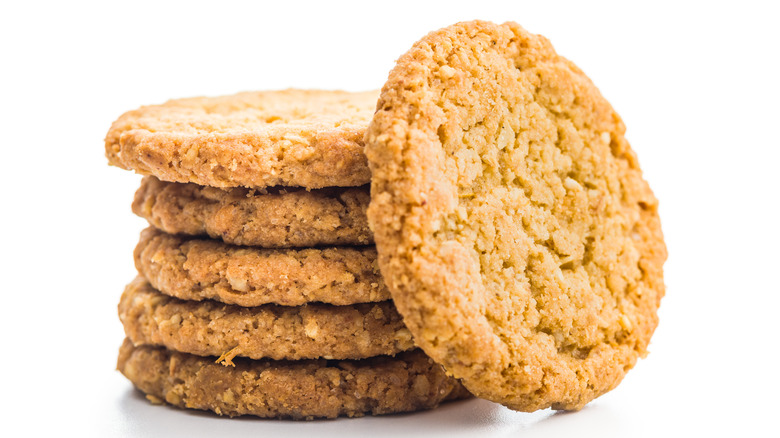Depression-Era Desserts That Deserve A Comeback
When the stock market crashed in 1929, the United States entered the Great Depression. For a decade, Americans had to stretch every dollar, and no part of their daily lives, including their diets, was unaffected. Since 25% of Americans were out of work during this time, they had to find creative ways to make their money and commodities last longer. Prior to the Depression, households enjoyed all of the meat, fresh produce, and dairy they wanted, but that quickly changed as income, and food supplies, dried up.
People had to get crafty in the kitchen, swapping more expensive and hard-to-obtain items, such as sugar and butter, for lower-cost, more readily available alternatives. Beans and potatoes became household staples, and vinegar often replaced lemon juice in recipes. Rice and pasta bulked up soup and stews, oats acted as fillers, canned meat became the norm, and crackers even stood in as apples in homemade pie. What started as survival techniques, however, turned into beloved family desserts and dishes that have been passed down through the generations. Many Depression-era desserts have become as forgotten as the Dust Bowl and soup kitchen lines, but these delicious sweets are worth another look — and helping.
Rice pudding
When you're craving a sweet and comforting dessert that won't break the bank, creamy rice pudding will hit the spot every time. The beauty of this Depression-era dessert is that you can use any type of leftover rice that's in your refrigerator to make it, and it requires few other ingredients. If you want your pudding to have a rich and creamy texture, use rice, such as long- or short-grain white and jasmine, that has a higher starch content.While you can use healthier, more nutrient-dense brown rice, the pudding may be a bit more chewy and have a slightly nutty flavor.
This is a fast and easy rice pudding recipe since it calls for just a handful of ingredients, most of which you probably already have on hand. The recipe also doesn't require any eggs, which would have made it a hit during the Depression days. To start, cook a ½ cup of white rice in 1 ½ cups of water or use 1 cup of leftover rice. By the way, here's an idiot-proof method for making perfect rice.
In a separate bowl, mix together ⅓ cup of granulated sugar, ¼ cup of cornstarch, and gradually add in 2 cups of whole milk. Whisk the ingredients well to incorporate, and then pour the liquid over a pot of cooked rice. Cook the mixture over medium heat, stirring constantly, for about a minute or until it's thickened. Top the pudding with cinnamon and raisins, or enjoy it plain.
Wacky cake
What makes this Depression-era cake so wacky? Well, the fact that it contains no milk, butter, or eggs, of course. Since those ingredients were tough to get a hold of during those meager days, this dessert could satisfy both your sweet tooth and your wallet. Also known as Depression, Joe, WWII, and dump cake, wacky cake was popular during a time when rationing ingredients was an essential part of daily life. Not only does this wackiest of cakes call for few ingredients, but you don't need any special kitchen gadgets to create it, either. Measuring tools, a whisk, a baking pan, and a few bowls will get the job done.
To make this chocolatey treat, preheat your oven to 350 Fahrenheit and grease an 8-inch square pan. Combine 1 ⅜ cups of all-purpose flour, 1 cup of granulated sugar, ¼ cup of cocoa powder, ½ teaspoon of salt, and 1 teaspoon of baking soda in one bowl, and 1 teaspoon of vanilla extract, 1 tablespoon of white or cider vinegar, ⅓ cup of vegetable oil, and 1 cup of cold water in another. Mix all of the ingredients together, pour the batter into the greased pan, and bake the cake for 30-35 minutes. Get creative and a bit more wacky by adding chocolate chips, shredded coconut, or any type of nuts to the batter.
The recipe works without the basic ingredients because flour gives it structure in place of eggs, the oil and extract lend moisture without any dairy, and the baking soda and vinegar create a chemical reaction that leavens the cake.
Mock apple pie
Another Depression-era dessert that seems to have an almost magical quality is mock apple pie. The reason this budget-friendly dessert has almost legendary status is because basic butter crackers replace apples, and it still tastes delicious. Although this pie was popular during the Depression since it omitted apples, which were hard to come by during that time since so many families lost their farms, it dates back to the mid-19th century. Pioneers crossing over the Great Plains made mock apple pies over campfires, and some early recipes called for more readily available breadcrumbs rather than crackers.
To make this ingenious pie yourself, the good news is that you don't have to start by peeling and slicing a bunch of apples. Simply preheat your oven to 450 degrees Fahrenheit, and place pie pastry in the bottom of 9-inch pan to prepare the crust. Mix together 2 cups of water, 2 teaspoons of cream of tartar, 1 ½ cups of granulated sugar, 1 teaspoons of lemon zest, and cinnamon to taste in a saucepan, and bring to a boil. Slowly drop 20 butter crackers into the mixture, one at a time, being careful not to break them. Boil the mixture for another two minutes, and then pour it into the pie shell. Cover with the top crust, cutting slits in the top for steam to escape. Bake the pie at 450 degrees Fahrenheit for six minutes and then lower the temperature to 350 degrees Fahrenheit for another 30 minutes.
Vinegar pie
Crafty vinegar pie is another dessert that dates back to the mid-19th century, but gained popularity during the Depression for several reasons. Since fresh fruit was hard to come by during the darkest of winter days, homemakers had to find creative ways to add tartness to their dishes. Distilled white vinegar was a pantry staple and was a stand-in for several "desperation pies" and other desserts. Even without any milk or dairy ingredients, this vintage vinegar pie still manages to have a smooth and creamy texture, similar to custard. The addition of sugar perfectly balances the tartness of the vinegar, which resembles the taste of lemons.
If you want to take a step back in time and make this old-fashioned pie at home, start by lining a 9-inch pan with either homemade, frozen, or refrigerated pie crust. Preheat your oven to 350 degrees Fahrenheit and combine 4 large eggs, 1 ½ cups of granulated sugar, 1 ½ cups of either white or apple cider vinegar, 1 teaspoon of vanilla extract, and ¼ cup of melted unsalted butter in a bowl. Pour the mixture into the crust and bake for 40-50 minutes, or until the top is golden brown. When people during the Depression era most likely enjoyed the pie as is, you can always top it with whipped cream as a decadent touch.
Water pie
Water pie is another penny-pinching dessert that manages to be delicious, smooth, and creamy without the addition of dairy or eggs. This nostalgic pie became a staple for homemakers who wanted to give their families a sweet treat with minimal resources. It has a gelatinous texture similar to that of chess pie, and doesn't have a lot of flavor beyond just being sweet, which isn't surprising with water as a main ingredient. Since we have access to more exotic ingredients these days, you can customize the flavor of the basic pie with lemon, orange, almond, or any other type of extract that you desire. A sprinkle of ground cinnamon over the top of the pie adds both flavor and aesthetic value.
Whip up this vintage pie by preheating your oven to 400 degrees Fahrenheit, and lining a 9-inch pan with your preferred type of crust. Next, pour 1 ½ cups of water into the prepared crust, and sprinkle in a combination of ¼ cup flour and 1 cup granulated sugar. Drop in 2 teaspoons of vanilla extract, and then top the mixture with 5 tablespoons of butter, divided into pats. Bake the pie at 400 degrees Fahrenheit for 30 minutes, and then 375 degrees Fahrenheit for 25-30 minutes.
Tomato soup cake
If you think that tomato soup only belongs in a bowl waiting to be dipped by a gooey grilled cheese sandwich, reconsider. Tomato soup cake entered the food scene in the 1920s, when the Campbell's Soup Company created the recipe to use with its condensed soup. During the Depression era, people stocked up on canned goods, and most likely had a few extra cans of tomato soup to transform into an easy, affordable dessert. The confection has a spice cake base, similar to carrot cake, and the tomato soup adds plenty of moisture and a bit of tangy sweetness.
To make this moist, flavorful dessert, preheat your oven to 350 degrees Fahrenheit, and grease a 10-inch cake pan. Sift together 3 cups of all-purpose flour and 1 teaspoon each of nutmeg, ground cloves, and cinnamon, using more or less of the spices according to your taste. Cream ¾ cup of shortening and 1 ½ cups of granulated sugar in one bowl, and combine 1 small can of tomato soup, ¾ cups of water, and 3 teaspoons of baking soda. Combine all of the ingredients, adding raisins and chopped walnuts as desired. Pour the cake batter into the greased pan, and bake for 60 minutes. Top the cooled cake with homemade or store-bought cream cheese frosting as a finishing touch.
Peanut butter bread
During the dark Depression days, Americans relied on peanut butter as a rich source of affordable protein, and it also made people feel fuller longer. As odd culinary combinations such as peanut butter and onions became popular, the creamy, nutty spread also found its way into desserts. Peanut butter bread hit the 1930s cookbook scene, and became a staple for homemakers wanting to give their families a sweet, yet hearty, treat. We all know that peanut butter is the perfect match to a slice of bread, so why not combine the two into one delicious dessert? You can also have fun with the toppings, slathering your homemade peanut butter bread with jams, jellies, honey, or just butter for a simple snack.
To revive this vintage dessert at home, start by preheating your oven to 350 degrees Fahrenheit, and greasing a loaf pan. Mix together 2 cups of all-purpose flour and 4 tablespoons of baking powder in one bowl, and 1 ¼ cups of peanut butter, ¾ cup of brown sugar, and 1 ¼ cups of whole milk in another. Combine all of the ingredients and stir in ¼ cup of chopped peanuts before scooping the batter into the loaf pan. Bake the bread for 45 to 55 minutes and allow it to fully cool before slicing. You can make this bread even sweeter and more decadent by adding chocolate or peanut butter chips, or a combination of both, to the batter.
Poor man's pudding
Warm, rich and comforting, poor man's pudding originated in Quebec, Canada, where the effects of the Great Depression were also being felt. The pudding is eggless and comprised mainly of pantry staples, which made it a popular, cost-efficient treat back in the day. Simple yet indulgent, the cake-like pudding gets it sweetness from maple syrup, which is poured directly into the homemade batter. The irony is that this once-affordable dessert is about to become pretty expensive in the near future, with the price of maple syrup expected to rise. If the syrup becomes too pricey for your budget, however, you can substitute it with a another type of syrup, such as agave, or even a sweet sauce made with brown sugar.
Make this decadent vintage dessert by preheating your oven to 350 degrees Fahrenheit, and buttering a 10x12-inch baking dish. Combine 3 cups of unbleached flour, 2 teaspoons of baking powder, and 1 teaspoon of salt in one bowl, and whip 2 cups of granulated sugar, 2 teaspoons of vanilla extract, and ½ cup of butter together in another. Combine all of the ingredients, along with 2 cups of milk, and pour the batter into the dish. Then, drizzle a mixture of 1 cup of maple syrup, 1 ½ cups of brown sugar, 1 ½ cups of water, and a ⅓ cup of melted butter over the batter before baking for 45 minutes. The pudding is traditionally served warm, and topped with ice cream or whipped cream if you desire.
Grape pie
Although grape pies may seem somewhat exotic and rare to us today, they were a lot more common during the Depression era. Grapes were more readily available than other types of produce at that time, as they could be grown on vines at home in the right climate. Grape pie recipes showed up in cookbooks in the 1930s, and many of them called for Concord, or muscadine grapes, which had to be skinned before using. You can still use the juicy, thick-skinned grapes when making this heirloom pie yourself, or opt for another type, such as green or red, if you prefer.
To make the pie the old-fashioned way, separate the skin from the pulp of 5 cups of Concord or muscadine grapes, and set it aside. Next, boil the grape pulp for a few minutes, and then push it through a sieve to separate and remove the seeds. Combine the seedless pulp and skin in a pot, cook them until they're tender, and then add 1 cup of granulated sugar, ¼ cup of all-purpose flour, 1 tablespoon of lemon juice. Mix well and then pour the grape filling into a pie plate lined with pastry dough. Add the top pastry dough, sealing the edges and cutting a vent in the center. Preheat your oven to 400 degrees Fahrenheit and bake the pie for 40 minutes, or until the crust is golden brown. Like all pies, this one tastes even better with a scoop of vanilla ice cream.
Poor man's cookies
When it comes to poor man's cookies, the name says it all. These sweet, crunchy round treats are similar to oatmeal cookies but they're made without eggs, milk, or butter. Since oatmeal was an affordable staple item and dairy products were harder to come by during the Depression, it's easy to see why these simple yet delicious cookies were so popular at the time. Like all good cookies, these oatmeal-based treats have a soft interior and slightly crunchy exterior, and deserve a comeback. Since we have easier access to more food items these days, you can update the recipe by adding chocolate or peanut butter chips, raisins, shredded coconut, or any type of nuts. If you're feeling really fancy, top them with icing or turn them into ice cream sandwiches.
The authentic Depression-era recipe says to preheat your oven to 350 degrees Fahrenheit, and mix ¾ cup shortening, 1 cup packed brown sugar, and ½ cup of granulated sugar in a large bowl until it's fluffy. Next, beat in ¼ cup of water and 1 teaspoon of vanilla extract. In another bowl, combine 1 cup of all-purpose flour, ¼ teaspoon of salt, and 1 teaspoon of baking soda, and add it to the shortening mixture. Finally, fold 2 cups of rolled oats in and then scoop the cookie dough onto a baking sheet. Bake the cookies in the preheated oven for 10 to 12 minutes. If you want to make similar treats with even fewer ingredients, check out these easy three-ingredient oatmeal cookies.


